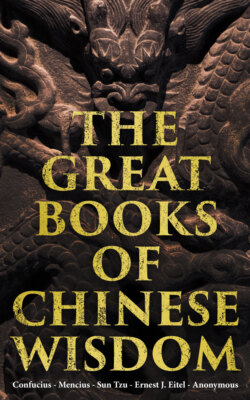Читать книгу The Great Books of Chinese Wisdom - Mencius - Страница 64
ОглавлениеHexagram XLVIII.48 Ȝing Hexagram
(Looking at) Ȝing, (we think of) how (the site of) a town may be changed, while (the fashion of) its wells undergoes no change. (The water of a well) never disappears and never receives (any great) increase, and those who come and those who go can draw and enjoy the benefit. If (the drawing) have nearly been accomplished, but, before the rope has quite reached the water, the bucket is broken, this is evil.
1. The first line, divided, shows a well so muddy that men will not drink of it; or an old well to which neither birds (nor other creatures) resort.
2. The second line, undivided, shows a well from which by a hole the water escapes and flows away to the shrimps (and such small creatures among the grass), or one the water of which leaks away from a broken basket.
3. The third line, undivided, shows a well, which has been cleared out, but is not used. Our hearts are sorry for this, for the water might be drawn out and used. If the king were (only) intelligent, both he and we might receive the benefit of it.
4. The fourth line, divided, shows a well, the lining of which is well laid. There will be no error.
5. The fifth line, undivided, shows a clear, limpid well, (the waters from) whose cold spring are (freely) drunk.
6. The topmost line, divided, shows (the water from) the well brought to the top, which is not allowed to be covered. This suggests the idea of sincerity. There will be great good fortune.
Footnotes
48. Ȝing, which gives its name to this hexagram, is the symbol of a well. The character originally was pictorial ( ), intended to represent a portion of land, divided into nine parts, the central portion belonging to the government, and being cultivated by the joint labour of the eight families settled on the other divisions. In the centre of it, moreover, was a well, which was the joint property of all the occupants.
What is said on Ȝing might be styled 'Moralisings on a well,' or Lessons to be learned from a well for the good order and government of a country.' What a well is to those in its neighbourhood, and indeed to men in general, that is government to a people. If rulers would only rightly appreciate the principles of government handed down from the good ages of the past, and faithfully apply them to the regulation of the present, they would be blessed themselves and their people with them.
In the Thwan we have the well, substantially the same through many changes of society; a sure source of dependance to men, for their refreshment and for use in their cultivation of the ground. Its form is what I have seen in the plains of northern China; what may be seen among ourselves in many places in Europe. It is deep, and the water is drawn up by a vessel let down from the top; and the value of the well depends on the water being actually raised. And so the principles of government must be actually carried out.
Line 1, being weak, and at the very bottom of the figure, suggests, or is made to suggest, the symbolism of it. Many men in authority are like such a well; corrupt, useless, unregarded.
Line 2 is strong, and might very well symbolise an active spring, ever feeding the well and, through it, the ground and its cultivators; but it is in an inappropriate place, and has no proper correlate. p. 167 Its cool waters cannot be brought to the top. So important is it that the ministers of a country should be able and willing rightly to administer its government. In the account of the ancient Shun it is stated that he once saved his life by an opening in the lining of a well.
Line 3 is a strong line, in its proper place; and must represent an able minister or officer. But though the well is clear, no use is made of it. I do not find anything in the figure that can be connected with this fact. The author was wise beyond his lines. After the first sentence of the paragraph, the duke of Kâu ceases from his function of making emblems; reflects and moralises.
Line 4 is weak, but in its proper place. Its subject is not to be condemned, but neither is he to be praised. He takes care of himself, but does nothing for others.
Line 5 is strong, and in its right place. The place is that of the ruler, and suggests the well, full of clear water, which is drawn up, and performs its useful work. Such is the good Head of government to his people.
Line 6 is in its proper place, but weak. If the general idea of the figure was different, a bad auspice might be drawn from it. But here we see in it the symbol of the water drawn up, and the top uncovered so that the use of the well is free to all. Then the mention of 'sincerity' suggests the inexhaustibleness of the elemental supply.
